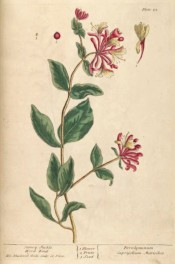Lonicera caprifolium L.
Fully hardy, woody, deciduous, twining climber with paired, oval leaves, to 10cm long, and axillary whorls of tubular, very fragrant, pink-flushed, creamy-white to yellow flowers, in summer. To 6m. [RHSE, Hortus, Hilliers’].
Horticultural & Botanical History
Long cultivated in England and Europe. The variety major was figured in Flore des Serres. [FS f.1120/1856]. ‘Wood-Bind or Honey-Suckle. Caprifolium or Peryclemenum. This shrub grows to the thickness of eight or ten inches in circumference, shooting out long slender stalks, which twist about everything they meet with; the leaves are a bluish green, and the flowers a pale red; which are succeeded by berries of a deeper red. It grows in most hedges, and flowers the greatest part of the summer. The leaves are sometimes put into the Gargarisma for sore throats. Some commend a decoction of them for a cough and the physic; and to open obstructions of ye liver & spleen. The oil, made by infusion of ye flowers, is accounted healing and warming, good for the cramp and convulsions of nerves. Mathiolus recommends the leaves & their juice as good in the Ointments that are used for wounds in the head, and ulcers in the legs.’ [Blackwell pl.25/1737].
History at Camden Park
Listed in all published catalogues [T.644/1843]. Not now planted in the gardens but it is a garden escapee which occurs in hedgerows in the wider Camden Park estate.
Notes
Lonicera caprifolium Ten. (1831) = Lonicera stabiana Guss. ex Pasq.
Lonicera caprifolium Schousb. (1800) = Lonicera etrusca Ten.
Published Jul 08, 2009 - 03:17 PM | Last updated Jul 16, 2010 - 02:01 PM
| Family | Caprifoliaceae |
|---|---|
| Category | |
| Region of origin | Europe, Asia |
| Synonyms |
|
| Common Name | Common honeysuckle, Italian honeysuckle, Goat-leaf honeysuckle, Italian woodbine |
| Name in the Camden Park Record | Lonicera caprifolium - Common Honeysuckle |
| Confidence level | high |
